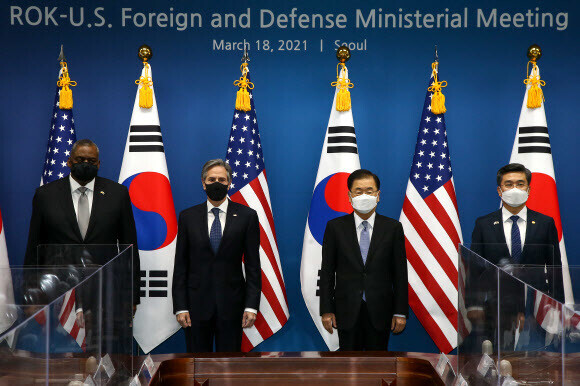hankyoreh
Links to other country sites 다른 나라 사이트 링크
S. Korea-US joint statement does not mention Quad or China, unlike that of US-Japan

A joint statement issued after a two-plus-two meeting of the South Korean ministers of foreign affairs and national defense was surprisingly blandly worded compared to the pointed statements about China and North Korea made early by US Secretary of State Antony Blinken.
In contrast with a US-Japan statement two days earlier that had been filled with strongly worded criticisms of China, the latest statement included no mention of two areas that had attracted major interest, namely China and the Quad framework of countries working to contain China.
While the statement released Thursday did affirm the “two countries' commitment to opposing all activities that undermine and destabilize the rules-based international order,” it did not specify China as the target of that criticism.
A South Korean Ministry of Foreign Affairs (MOFA) official closely acquainted with the meeting avoided giving an immediate reply, insisting that they could “not speak about the content of the bilateral discussions.”
“As far as I’m aware, it is unusual to mention specific countries in joint statements,” the official added, while declining outright to comment on whether the US asked for China to be mentioned by name or, if so, how South Korea reacted.
In contrast, the US-Japan joint statement shared Tuesday made no bones about the two sides’ aims of reining China in — with roughly one-third of its content consisting of criticisms of China.
It included outspoken references not only to the conflict surrounding the Senkaku Islands (known in China as the Diaoyu Islands), which is one of the main security issues Japan faces, but also to the issues of Hong Kong, Taiwan and Xinjiang, which China has described as “key interests” where it is unwilling to make any concessions.
In contrast, Japan had not mentioned China in any of the joint statements released after its three previous rounds of two plus two meetings.
An examination of the Tuesday US-Japan document and Blinken’s outspoken criticisms of China on Wednesday and Thursday suggests a strong likelihood that the US initially asked South Korea to also include references to China in the statement, expressing a similar tenor to the one from Japan.
But that plan appears not to have panned out due to objections from Seoul, which is seeking to maintain a delicate balance between Washington and Beijing.
Within MOFA, many saw the unusually strongly worded condemnations of China that Blinken shared before reporters ahead of the South Korea-US foreign ministers’ meeting on Wednesday as having been made in lieu of references in the joint statement coordinated by the two sides, in reflection of the attitude expressed by Seoul.
By Gil Yun-hyung, staff reporter
Please direct comments or questions to [english@hani.co.kr]

Editorial・opinion
![[Column] Season 2 of special prosecutor probe may be coming to Korea soon [Column] Season 2 of special prosecutor probe may be coming to Korea soon](https://flexible.img.hani.co.kr/flexible/normal/500/300/imgdb/original/2024/0426/3317141030699447.jpg) [Column] Season 2 of special prosecutor probe may be coming to Korea soon
[Column] Season 2 of special prosecutor probe may be coming to Korea soon![[Column] Park Geun-hye déjà vu in Yoon Suk-yeol [Column] Park Geun-hye déjà vu in Yoon Suk-yeol](https://flexible.img.hani.co.kr/flexible/normal/500/300/imgdb/original/2024/0424/651713945113788.jpg) [Column] Park Geun-hye déjà vu in Yoon Suk-yeol
[Column] Park Geun-hye déjà vu in Yoon Suk-yeol- [Editorial] New weight of N. Korea’s nuclear threats makes dialogue all the more urgent
- [Guest essay] The real reason Korea’s new right wants to dub Rhee a founding father
- [Column] ‘Choson’: Is it time we start referring to N. Korea in its own terms?
- [Editorial] Japan’s rewriting of history with Korea has gone too far
- [Column] The president’s questionable capacity for dialogue
- [Column] Are chaebol firms just pizza pies for families to divvy up as they please?
- [Column] Has Korea, too, crossed the Rubicon on China?
- [Correspondent’s column] In Japan’s alliance with US, echoes of its past alliances with UK
Most viewed articles
- 1‘We must say no’: Seoul defense chief on Korean, USFK involvement in hypothetical Taiwan crisis
- 2AI is catching up with humans at a ‘shocking’ rate
- 3[Column] Season 2 of special prosecutor probe may be coming to Korea soon
- 4Division commander ordered troops to enter raging flood waters before Marine died, survivor says
- 5Is Japan about to snatch control of Line messenger from Korea’s Naver?
- 6The dream K-drama boyfriend stealing hearts and screens in Japan
- 7Korea protests Japanese PM’s offering at war-linked Yasukuni Shrine
- 8“Korea is so screwed!”: The statistic making foreign scholars’ heads spin
- 9‘Weddingflation’ breaks the bank for Korean couples-to-be
- 10Korea sees more deaths than births for 52nd consecutive month in February